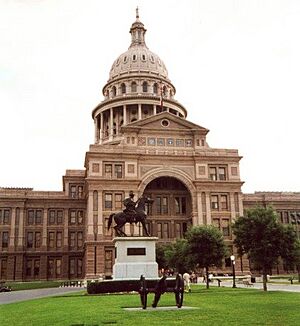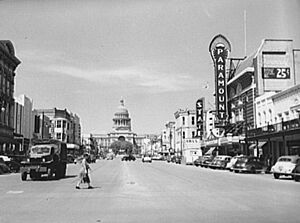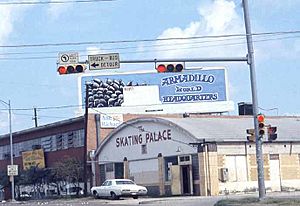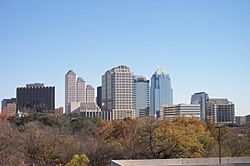History of Austin, Texas facts for kids

Austin, Texas, is a vibrant city with a rich history. After Texas became independent from Mexico in 1836, its government moved around a lot. To fix this, leaders decided to find a permanent capital city. In 1839, President Mirabeau B. Lamar helped choose a spot called Waterloo. This area was along the Colorado River, near Shoal Creek.
The new capital was named Austin to honor Stephen F. Austin, a key figure in Texas history. The first land lots in Austin were sold in August 1839. Austin's story is deeply connected to Texas politics. Later, the University of Texas made Austin a major center for learning. The city also became famous for its music, earning the nickname "Live Music Capital of the World." Austin has grown a lot, becoming one of the fastest-growing big cities in the United States.
Contents
Early Days: Ancient History and First Settlers
Evidence shows people lived in the Austin area at least 11,000 years ago. Some of the oldest archaeological sites in Texas are found nearby. Hundreds of years before Europeans arrived, various nomadic Native American tribes lived here. They fished and hunted along the creeks, especially around Barton Springs, which was a popular campsite.
When Austin was founded, the Tonkawa tribe was common in the area. Comanches, Lipan Apaches, and Waco tribes also visited often.
European Arrivals and the Birth of Waterloo
The first European visitors were Spanish friars in 1730. They set up three temporary missions near the Colorado River and Barton Springs. However, they soon moved to the San Antonio River. After Mexico gained independence from Spain, Anglo-American settlers began moving into Texas.
By the 1830s, they reached what is now Central Texas. In 1838, Edward Burleson surveyed the site of Austin, calling it Waterloo. It was a small settlement with only about twelve people before it was chosen as the new capital.
Austin Becomes the Capital City
By 1836, the Texas Revolution ended, and the Republic of Texas was independent. For a few years, the capital moved between several towns. Finally, President Sam Houston moved the capital to Houston in 1837.
Choosing a Permanent Capital Location
After Mirabeau B. Lamar became president, the Texas Congress looked for a permanent capital. Lamar wanted the capital to be further west. He visited the area in 1838 and was impressed by its beauty and natural resources. The commission bought 7,735 acres (3,130 ha) along the Colorado River. This land included the planned townsite of Waterloo.
Many Texans, including Sam Houston, worried about the new capital being so far west. They feared attacks from Mexican troops and Native Americans. But Lamar believed it was a great central spot, connecting roads to San Antonio and Santa Fe.
Designing the New City of Austin
In 1839, the Texas Congress officially named the new city Austin. Local stories say that Stephen F. Austin made a peace treaty with Native Americans under the famous Treaty Oak. Today, some local businesses like Waterloo Ice House and Waterloo Records honor the city's original name.
Judge Edwin Waller was chosen to plan and build Austin. He picked a 640-acre (259 ha) site on a bluff above the Colorado River. It was located between Shoal Creek to the west and Waller Creek (named after him) to the east. Waller and his team created Austin's first city plan, known as the Waller Plan. They divided the area into a grid plan of 14 blocks in each direction.
A main street, named "Congress" by Lamar, ran through the center from Capitol Square to the Colorado River. Streets running north and south were named after Texas rivers. East and west streets were named after local trees, though they were later changed to numbers in 1884. Much of this original plan is still visible in downtown Austin today.
In October 1839, the entire Texas government moved to Austin by oxcart. By January, the town had 839 people. France even sent a diplomat, Alphonse Dubois de Saligny, who built the French Legation in 1840. This is Austin's oldest documented wooden building. Also in 1839, the Texas Congress set aside land for a "university of the first class." This land became the central campus of the University of Texas at Austin in 1883.
Statehood and the Civil War Era

Austin slowly recovered, and its population reached 854 by 1850. The city grew much faster after it won an election in 1850 to remain the state capital for the next twenty years. For the first time, the government built permanent structures. These included a new capitol building finished in 1853 and the Governor's Mansion completed in 1856.
By 1860, Austin's population had grown to 3,546 people. While Texas voted to leave the Union and join the Confederacy in 1861, Travis County (where Austin is) voted against it. However, once the war began, many men from Austin and Travis County joined the Confederate army. Austin was never directly attacked during the war, but people faced shortages and rising prices.
After the Civil War: Changes and Growth
When the Civil War ended in April 1865, there was some disorder in Austin. The governor fled, and a group of men tried to rob the state treasury. A gunfight happened, but the robbers escaped with some money.
After the war, Union troops occupied the city. Austin's African-American population grew significantly. Newly freed Black residents established communities like Masontown, Wheatville, Pleasant Hill, and Clarksville. By 1870, Black residents made up about 36 percent of Austin's population.
Austin in the 20th Century
Living with the Colorado River
Austin's history is closely linked to the Colorado River. In the 1890s, city leaders wanted to build a dam on the river. They hoped cheap hydroelectric power would attract factories and make Austin a busy industrial city. In 1893, the 60-foot-high Austin Dam was finished.
By 1895, electricity from the dam powered streetcars and the city's new water and light systems. The dam created a lake, known as "Lake McDonald," which attracted new residents and developers. Austin boomed in the mid-1890s, and 31 new 165-foot-high moonlight towers lit up the city at night.
However, the dam had problems. It was built on a fault line, and silt quickly filled half the lake. The dam couldn't produce enough steady power for factories, so the manufacturers never came. On April 7, 1900, a spring storm caused the dam to break apart. The flood killed 18 people and destroyed 100 houses.
After the disaster, Austin residents still wanted city-owned electricity. They bought out a private power company, which led to today's Austin Energy utility. The city tried to rebuild the dam, but it was damaged again by a flood in 1915. The ruined dam sat until the Lower Colorado River Authority (LCRA) rebuilt it as Tom Miller Dam, completed in 1940.
This new dam, along with larger dams upstream like Mansfield Dam (forming Lake Travis) and Buchanan Dam (forming Lake Buchanan), brought many benefits. These included cheap hydroelectric power, an end to major flooding, and a steady water supply for the city's future growth.
City Improvements and Planning

Between 1880 and 1920, Austin's population tripled to 34,876. However, the city fell from being the fourth largest in Texas to the tenth largest. Austin began to focus on being a residential city. In 1886, the Driskill Hotel opened, becoming Austin's first fancy hotel.
By 1905, Austin had few paved streets and public parks. In 1908, voters changed the city government to a commission government. This led to improvements in city services. The Littefield and Scarborough buildings, Austin's first skyscrapers, opened in 1909. In 1910, the concrete Congress Avenue Bridge was built across the Colorado River, helping development south of the river.
In 1918, the city acquired Barton Springs, a spring-fed pool that became a symbol of Austin. In 1924, Austinites voted to adopt a council-manager government, which is still used today. A 1928 city plan aimed to develop Austin as a residential, cultural, and educational center. This plan led to funding for streets, sewers, parks, a hospital, the first public library, and the first municipal airport, which opened in 1930.
Race and the 1928 City Plan
In the early 1900s, African-Americans lived in various communities across Austin. These neighborhoods often had churches, businesses, and schools. However, the 1928 Austin city plan recommended that East Austin be a "Negro district." City officials moved most Black residents from the western part of the city to East Austin, east of what is now Interstate 35.
City services like schools and parks were mainly provided to Black residents only in East Austin. By the mid-1900s, Austin was still segregated in many ways, including housing, restaurants, and schools. However, African Americans built their own strong institutions, including businesses, churches, and colleges.
Austin's Hispanic population also grew significantly. By the 1940s, most Mexican-Americans lived in East Austin. While they faced discrimination, it was not as strict as the segregation against African-Americans.
Between the 1950s and 1980s, ethnic relations in Austin changed. Local Black leaders worked to end segregation in schools and services. In 1956, the University of Texas was the first major university in the South to admit Black undergraduate students. In the early 1960s, students protested against segregated lunch counters and movie theaters. The United States Civil Rights Act of 1964 helped end public discrimination. African-Americans and Hispanics also gained political power, winning seats on the school board and city council.
Growth During the Great Depression
During the 1930s, Austin felt the effects of the Great Depression. However, the city did relatively well because of its strong government and education sectors. Mayor Tom Miller and U.S. Congressman Lyndon Baines Johnson helped secure funding for projects. Austin's population grew by 66 percent during this decade.
The Public Works Administration provided Austin with more money for construction than any other Texas city at the time. The University of Texas nearly doubled its student enrollment and built many new buildings. In 1930, the Robert Mueller Municipal Airport also opened.
Post-War Growth and Challenges
From 1940 to 1990, Austin's population grew rapidly, from 87,930 to 472,020. By 2000, it reached 656,562. The city's area also expanded greatly. Much of this growth came from the expansion of education and government. The University of Texas at Austin doubled its student numbers in the 1960s. State government jobs also tripled.
In the 1970s, Austin became a hub for high technology. Companies like IBM, Texas Instruments, and Motorola moved to Austin. This growth was boosted by research programs at the University of Texas. By the early 1990s, the Austin area had about 400 high-tech manufacturers. Downtown Austin also saw new office buildings and hotels, and a new convention center opened in 1992.
On August 1, 1966, a former Marine named Charles Whitman killed his wife and mother. He then went to the UT Tower and shot people below, killing 14 others before police stopped him.
Austin in the 1970s and 1980s
During the 1970s and 1980s, Austin experienced a huge building boom. This led to conflicts between people who wanted to preserve the city's natural beauty and those who wanted more development. Protecting Barton Springs and the Edwards Aquifer became a major issue.
Many neighborhood groups formed to protect their areas from too many apartment complexes and traffic. Environmentalists worked to protect streams, lakes, and hills. They helped pass laws to protect the environment. A program started in 1971 to beautify the shores of Town Lake (now Lady Bird Lake). People also worked to save and restore historic buildings.
Austin became known as a place for creative people. Many local businesses were replaced by larger chain stores. This made some longtime Austinites feel like the city was losing its unique culture. In the 1970s, Austin became a haven for country and western musicians like Willie Nelson and Stevie Ray Vaughan. In 1975, Austin City Limits premiered on PBS, showing Austin's music scene to the country.
The Armadillo World Headquarters became famous in the 1970s as a place for both new and well-known musicians. Austin gained a reputation as a city where musicians could start their careers in informal venues. This eventually led to the city's official motto, "The Live Music Capital of the World."
Austin in the 1990s to Today
In the 1990s, Austin's growth continued with a large technology industry boom. While big companies like IBM were already here, Austin also became a center for the dot-com boom (and later bust). Austin is also known for game development, filmmaking, and popular music. On May 23, 1999, Austin-Bergstrom International Airport opened, replacing the old airport.
In 2000, Austin was in the spotlight as the headquarters for presidential candidate and Texas Governor George W. Bush. In the same election, Austinites voted against a light rail proposal. However, in 2004, they approved a commuter rail service from Leander to downtown, which began in 2010.
In 2004, the Frost Bank Tower opened downtown. At 515 feet (157 m), it was the tallest building in Austin and the first high-rise built after September 11, 2001. Many other tall buildings, mostly homes or mixed-use, have since changed Austin's skyline.
In 2006, the first parts of Austin's toll road network opened. These roads were meant to help with traffic, but some people felt the tolls were an extra tax. In March 2018, a series of explosions in Austin killed two people and injured five others.
Today, Austin continues to grow rapidly. Many young people are drawn to the city because of its strong economy, its reputation for liberal politics, and its relatively lower housing costs compared to other parts of the country. This fast growth has brought challenges, such as urban sprawl and balancing new buildings with environmental protection. The city is now focusing on "smart growth" in downtown and nearby areas. This has led to new condominiums and a changing skyline. While downtown has been revitalized, housing development hasn't kept up with demand, leading to higher housing costs.
Images for kids
-
The first U.S. president to visit Austin, William McKinley, with Texas governor Joseph D. Sayers.







